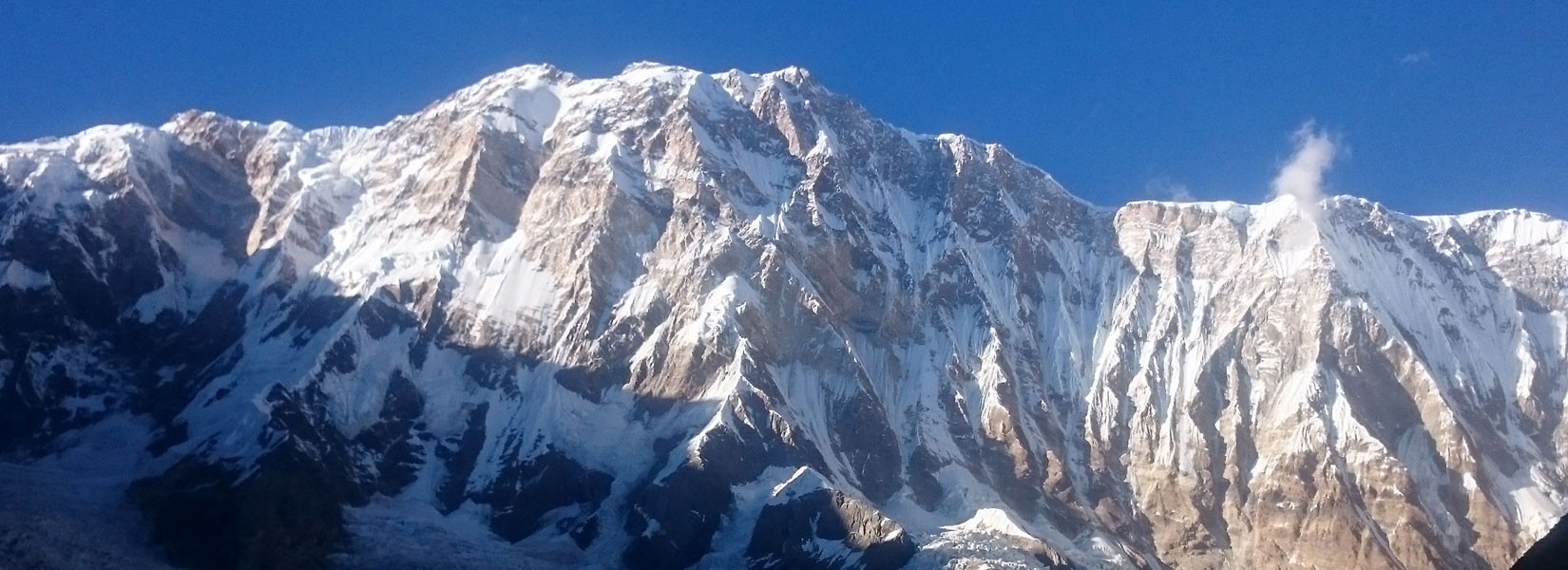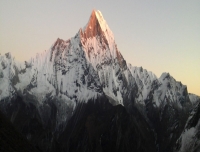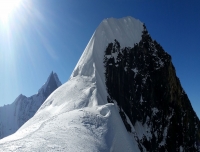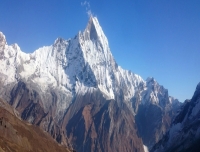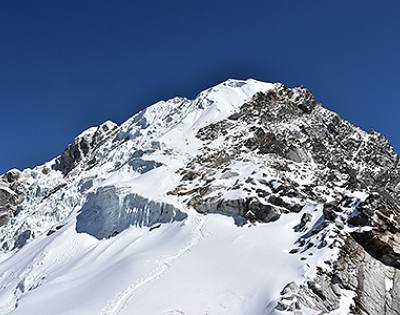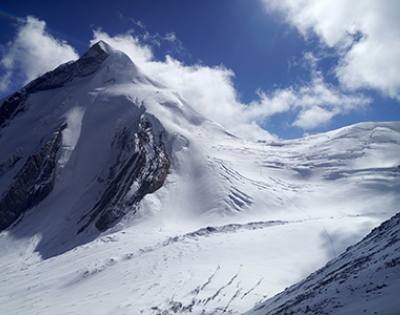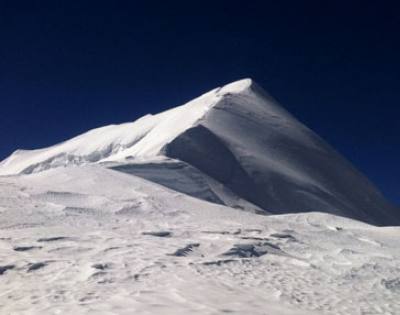- Read Reviews onTripadvisor
- Phone & WhatsApp Support+977 9851112535 (Chandra Shor)
Tent Peak Climbing (Tharpu Chuli) [5,695 meters/ 18,684 ft] | 22 Days
Fact Information
- Duration
- 22 Days
- Destination
- Nepal
- Difficulty
- Difficult
- Accommodation
- Hotel, Lodge &Tent
- Activity
- Peak Climbing
- Transportation
- Tourist Bus, Car, Jeep, Air-plane
- Meals
- BLD (Breakfast, Lunch and Dinner)
- Max Person
- 18
- Min Person
- 1
- Maximum altitude
- [5,695m/18,684ft]
- Best season
- Autumn & Spring
About Trip
Tharpu Chuli Peak is a magnificent mountain located in the Annapurna region of Nepal. It offers breathtaking panoramic mountain views and presents natural and cultural beauty. During the trek, you will pass through beautiful villages, terraced farmlands, and green lush forests with a spectacular landscape. You will have the opportunity to visit remote villages, explore local people's culture and lifestyle, and enjoy their warm hospitality and local cuisine.
The trek to Tharpu Chuli Peak usually starts from Pokhara, a popular tourist destination in Nepal. You can reach there by a short flight or a long drive from Kathmandu. The trek to the peak is an interesting climb with easy access. It is part of the ridgeline located south of the glacier dome and includes SingaChuli (Fluted Peak) at 6,501 meters (21,328 ft), which serves as a central divider between the semicircles of peaks enclosing the sanctuary. Climbing to the summit of Tharpu Chuli involves scrambling on large glaciers, rock fall zones, moraines, huge boulders, steep grassy hills, crevasses, and steep snow wall edges. It’s quite challenging to climb, but the rewarding view makes it all worth it.
The summit of Tharpu Chuli presents truly captivating views of the surrounding Himalayan peaks, including Annapurna One, the tenth highest mountain in the world. Climbers will be rewarded with a superb panorama of Himalayan peaks, including Himchuli, Annapurna South, Bharara Shikhar (Annapurna Fang), Gangapurna, Annapurna III, Machhapuchhare, and many others. The climb to the summit of Tharpu Chuli is often combined with the Annapurna Ghorepani Poon Hill Panorama Trek for an extended adventure and the best climbing preparation.
At Himalayan Diamond Adventure Team, we highly recommend climbing Tharpu Chuli for an unforgettable and enjoyable experience. The climb to the summit of Tharpu Chuli is challenging, but with proper preparation and guidance from our experienced team, it is an achievable feat. With its stunning panoramic views and challenging climb, Tharpu Chuli Peak is a must-visit destination for adventure seekers and climbers.
Trip Highlights
Breathtaking Views: Tharpu Chuli offers spectacular panoramic views of the surrounding Himalayan peaks, including Annapurna One, the tenth highest mountain in the world, Himchuli, Annapurna South, Bharara Shikhar (Annapurna Fang), Gangapurna, Annapurna III, and Machhapuchhare.
Natural Beauty: The climb to Tharpu Chuli takes you through beautiful villages, terraced farmlands, lush forests, and stunning landscapes.
Cultural Experience: The trek to Tharpu Chuli provides an opportunity to explore the local culture and lifestyle of the Nepalese people. You can visit remote villages, interact with the locals, and enjoy their warm hospitality.
Challenging Climb: Climbing Tharpu Chuli is a challenging feat, involving scrambling on large glaciers, rock fall zones, moraines, huge boulders, steep grassy hills, crevasses, and steep snow wall edges. It requires proper preparation and guidance from experienced climbers.
Accessibility: Tharpu Chuli is easily accessible from Pokhara, a popular tourist destination in Nepal, and can be reached by a short flight or a long drive from Kathmandu.
Annapurna Ghorepani Poon Hill Trek: The climb to Tharpu Chuli is often combined with the Annapurna Ghorepani Poon Hill Panorama Trek, which provides an extended adventure and the best climbing preparation.
Outlined Itinerary
Day 01: Arrival in TIA of Kathmandu (1,350 meters), and transfer to hotel
Day 02: Preparation Day for Mera Peak climbing.
Day 03: Drive to Pokhara 820 meters (2,690 ft), transfer to hotel.
Day 04: Drive bus to Hille and trek start to Ulleri 1,960m (6,430 ft), 8hrs.
Day 05: Trek from Ulleri to Ghorepani 2,860 meters (9,383 ft), 7hrs.
Day 06: Poon-hill 3,210 me (10,531 ft), Sunrise view, trek to Tadapani 2,630m (8,628 ft), 5hrs.
Day 07: Trek from Tadapani to Chhomrung 2,170 meters (7,119 ft), 7hrs.
Day 08: Trek from Chhomrung to to Dovan 2,600 meters (8,530 ft), 7hrs.
Day 09: Trek from Dovan to Machhapuchhare base camp 3,700 m (12,139 ft), 7hrs.
Day 10: Trek from MBC to ABC 4,130 meters (13,550 ft), 2hrs.
Day 11: Trek to Tent peak high camp 4,600 m (15,092 ft), 8 hours.
Day 12: Entirely climbing practicing day.
Day 13: Ascent of Tent peak 5,695 m 918,687 ft) 12 hours.
Day 14: A Contingency day
Day 15: Switch back to Himalaya hotel 2,680 m 98,792 ft) 4 hours.
Day 16: Trek back to Shinuwa village 2,260 m (7,414 ft) 8 hours.
Day 17: Trek to Ghandruk 1,940 meters (6,364 ft), 8 hours.
Day 18: Head to Sarangkot 1,552 meters (5,092ft).
Day 19: Trek to Lakeside Hotel, 820 m (2,690ft), 2 hours.
Day 20: Free sightseeing in Pokhara
Day 21: Fly back to Kathmandu 1,350 m (4,429ft), transfer to hotel.
Day 22: Departure for home.
Detailed Itinerary
Day 01: Arrival in Kathmandu Airport 1,350 meters (4,429 ft), transfers to hotel.
Representatives from Himalayan Diamond Adventures will greet you upon your arrival at Tribhuvan International Airport in Kathmandu. You will be welcomed with a fresh flower garland, a traditional Nepali greeting, and then escorted to the hotel for bed and breakfast service. The drive from the airport to the hotel takes approximately 15 to 20 minutes, if there is no traffic jam on our way. After checking into the hotel, we will have a short refreshment meeting at the hotel. In the evening, the company will host a welcome dinner at a traditional Nepali restaurant, complete with a cultural dance performance, to celebrate the start of your trip. During the dinner, your guide will provide a brief overview of the schedule for the following day.
Day 02: Climbing preparation day,
Today is our trip preparation day. If you are not well equipped, it is a good idea to gather climbing gear before leaving for a mountain trip. There are many trekking gear shops around Thamel Bazaar where you can purchase the necessary equipment, or you can rent it. If you decide to rent, you will need to leave a deposit at the trekking shop.
Day 03: A scenic bus journey to Pokhara 820 meters (2,690 ft), 200km, 7hrs transfer to hotel.
Today, we will be traveling to another famous tourist destination in Nepal, Pokhara, by tourist bus. The journey will take approximately 7 hours and along the way, you will be able to witness the stunning mountain terrain, including the Ganesh Himalaya range, Bhauda Himal, Rani peak, group of Himalchuli, Ngadi chuli, Manasalu, Lamjung, Machhapuchhare, Annapurna III, Annapurna II, Annapurna south, and many other mountains. Additionally, the land is also rich in beautiful landscapes, such as cultivated lands, perennial rivers like the Trisuli river and Marsyangdi river, eye-catching waterfalls, and rolling green hills. Pokhara itself is a truly beautiful city surrounded by white snow-capped towering peaks and green hills, and one of its main attractions is its serene lakes, where visitors can swim and go boating.
Day 04: Drive to Hille and trek starts to Ulleri 1,960 meters (6,430 ft), about 7 hours.
We will embark on a scenic bus journey from Pokhara to Nayapul-Hille, which is where the Ghopepani Poon hill trek officially begins. The trail passes through several villages and cultivated lands owned by farmers, including terraced rice fields, potato, barley, maize, and vegetable farms. As we follow the north bank of Burundi Khola, we will pass through villages offering astounding views. After a 2-hour scenic bus journey, we will begin the trek to Ulleri village, passing through Tikhedhungga village. Once we leave Tikhedhungga, the trail will steeply climb up the mountainside, following thousands of stone staircases. The route is challenging, but the views along the way make it worthwhile.
Day 05: Trek to Ghorepani 2,860 meters (9,383 ft), 7 hours walk through green lush forest.
We will commence our trek towards Ghorepani, gradually ascending uphill. Ghorepani is situated at an elevation of 2,860 meters (9,383 ft) above sea level. Leaving Ulleri village, we will pass through several beautiful ethnic group's villages before reaching Ghorepani, which is an enchanting and bustling tourist destination. The trail can be quite challenging for novice trekkers, but the magnificent views of Machhapuchre make it worthwhile. After a short and enthralling hike, we will pass through oak, rhododendron, and magnolia forests towards Banthanti and Nangethati, which are popular stops on the way to Ghorepani. At the end of our beautiful hiking day, we will reach Ghorepani, a large Poon Magar inhabited settlement situated between two green hills that resemble a saddle. Ghorepani is a vibrant and highly touristy village.
Day 06: Climb Poon - hill 3,210 meters (10,530 ft), for sunrise view and trek down to Tadapani 2,630 meters (8,628 ft).
We will wake up early in the morning, at dawn, and climb up to Poon Hill at 3,210 meters (10,531 ft) to enjoy the splendid sunrise and panoramic views of the Annapurna Himalaya range, including Mt. Dhaulagiri and Manaslu. When the first sun rays hit the mountains, it creates a marvelous view. After enjoying the breathtaking views of Dhaulagiri and Annapurna, we will head back to the hotel for a hot breakfast. Following breakfast, we will trek to Tadapani, enjoying the tranquility and scenic views of the rhododendron, dwarf bamboo, oak, and pine jungle along the way
Day 07: Scenic Village trek to Chhomrong 2,170m (7,119 ft), 7 hours of walk.
Today, our destination is Chhomrung, the third biggest and busiest tourist village on the way to the ABC trek. Our journey begins with a descent down to Kumrung Khola, passing through dense rhododendron forests before reaching tea houses and the village, where we can enjoy incomparable scenery. From there, our trail steeply drops down to Kumrung Khola, which we cross over a well-made suspension bridge. Continuing on, we pass through cultivated farmlands and villages, following a slightly uphill path to reach Chhomrung, home to Gurung and Magar lodges that offer rewarding mountain views.
Day 08: Trek to Dovan 2,600 meters (8,530 ft), 7 hours of walk.
Leaving our lodge, the trail descends to Chhomrung Khola, passing through the expanding Chhomrung village. We will cross the river over a suspension bridge before quickly ascending to Shinuwa village. Our route then leads to Dovan, passing through rhododendron and bamboo forests. Today, most of our trek is through bamboo-covered forests, offering awe-inspiring views of Annapurna South, Huchuli, and Fishtail. Although the trek today is more strenuous, we will be filled with enthusiasm as there is so much to explore and enjoy in the wilderness of the Himalayas.
Day 09: Trek to Machhapuchhre base camp 3,700m (12,139 ft) along the rugged path.
After breakfast, we will trek through the mountainous terrain covered with dwarf bamboo forest. Today's route will be more rugged and uphill than the previous days. We will cross famous landmarks such as the Hinku cave and Deurali lodges as we traverse several ascents towards the Sanctuary. We will then continue our trek until we reach the Machhapuchhre Base Camp, which usually takes about 7 to 8 hours from Dovan.
Day 10: Trek to Annapurna base camp 4,130 m (13,550 ft), with surrounding Mountain view.
Today, we will trek to the Annapurna Base Camp, which is located at an elevation of 4,130 meters above sea level. The base camp offers breathtaking panoramic views, including a stunning view of Annapurna One.
From Machhapuchhre Base Camp, we will continue our ascent until we reach the Annapurna South Base Camp. The climb is challenging, but the experience is incredibly rewarding, with sprawling mountain views all around us. Once we reach the Annapurna Base Camp, we will only need to walk for 2-3 minutes to reach a picturesque spot to witness the immense Annapurna glaciers. Although the journey to Annapurna Base Camp can be quite challenging, the awe-inspiring mountain views make it all worthwhile.
Day 11: Trek to Tent peak high camp [4,600 meters/15,092ft], walk 8 hours:
From Annapurna Base Camp, the trail leads to Tent Peak High Camp. Struggling against the glaciated, moraine, and slippery grassy uphill, finally reach the targeted destination at (4600 meters, 15,092ft). There are other options for those who not wish to climb. Hiking from camp can be quite pleasurable and adventurous. Sightseeing exotic ecosystem and breath-taking vistas of Himalayan peaks of Nepal can be equally satisfying. We spend overnight in the tented camp (service includes dinner and breakfast with a hot drink like tea or coffee).
Day 12: Entirely climbing practicing day, we demo you some climbing tips:
After our breakfast, we start climbing practice, like equipment’s demonstration, raking, packing, and climbing techniques. It can build up our confidence for the strenuous and enjoyable summit day. On this day, our climbing guide and assistant guide will go to the peak for open trail and put fix line ropes on the ridges of the peak to make your climbing easy. We spend overnight in the camp (service includes dinner and breakfast with a hot drink like tea or coffee).
Day 13: Ascent of Tent peak [5,695 meters/18,687ft], walk about 12 hours, back to high camp:
Today, we wake up at 02: 00 am for tea with light breakfast and then we head out to ascent in the dawn with a headlamp. After traversing on the moraine, we reach snowbound land. And then, we climb about 250 meters 30 to 80 degrees' snow and ice slope to catch the main summit ridge. Finally, we scale the summit of Tent Peak. From an altitude of 5695 meters, we can have a mind-blowing view of the circling mountains. From here two routes to get top of the peak, one route goes along the ridge, which is for technical climber and another normal route moves to behind of Tent Peak for a normal climber. We descend back to high camp. We spend overnight in the camp (service includes dinner and breakfast with a hot drink like tea or coffee).
Day 14: A Contingency day:
Since there is no guarantee that we will have favorable weather on our tentative itinerary to cross pass or glacier traverse, so we need some spare days to cover our trip program. A spare day is in case of any problems affecting our schedule. If unused at this point, this is a fantastic location and the day can be used for exploration of the valley. We spend overnight in the camp (service includes dinner and breakfast with a hot drink like tea or coffee).
Day 15: Switch back to Himalaya hotel [2,680 meters/8,792ft] walk 4 hours
After wonderful trekking and peak climbing, we head back to Himalaya Hotel. Leaving base camp, the trail drops to Himalayan hotel crossing many rugged lands with beautiful landscapes. After trekking off 4 hours to continue downhill, we come back Himalayan hotel. We spend overnight at the lodge (service includes dinner and breakfast with a hot drink like tea or coffee).
Day 16: Trek back to Shinuwa village [2,260 meters/7,414ft] walk about 8 hours:
After leaving from Himalayan hotel, the trail gently descends through a dense bamboo forest to Bamboo hotel, and further, the trail steeply rises up to Shinuwa jungle T-houses through oak, rhododendron, alder, and bamboo forest. We spend overnight at the lodge (service includes dinner and breakfast with a hot drink like tea or coffee).
Day 17: Trek to Ghandruk 1,940 meters (6,364ft), 8 hours of soothing walk:
After the retreat of Chhomrong village, there are more than three alternative routes back to Pokhara, via Jhinu danda and Landrung village Potana, Dhampus, Dhampus Phedi, or via Jhinu danda and Seuli bazaar Nayapul. We follow the trail above the cultivated fields of potato and wheat before descending to the village of Kumrung above the Khumrung Khola. After crossing the river, the trail moves steeply uphill to the way of Ghandruk danda, then trail continuously towards to Ghandruk Gurung Gorkha army village. After walking off 8 hours continuously to ahead from Chhomrong reach to Ghandruk, which is a major inhabitant of the Gurung community. They have their own dialect, culture, and warm hospitality. Ghandruk is a more touristy destination in this valley. We spend overnight at the lodge (service includes dinner and breakfast with a hot drink like tea or coffee).
Day 18: Head to Sarangkot 1,552 meters (5,092ft), drive to Nau Danda and trek to Sarangkot:
After leaving Ghandruk village, we walk slightly downhill along the stone staircase to reach Jeep station Kimche to catch Jeep. Today, we drive up to Nau danda throughout the terraced farmlands, and farmer’s villages, Tikhedhunga, Nayapul. Driving off an hour and 30 minutes, we reach to Naudanda and then we trek to Sarangkot 2 hours along the off-road. Sarangkot offers captivating mountain views and a miraculous view of the Pokhara valley. We spend overnight at the guest house (service includes dinner and breakfast with a hot drink like tea or coffee).
Day 19: Trek to Lakeside Hotel, 820 meters (2,690ft), 2 hours of vertical down way:
After an outstanding sight of surrounding mountains such as Machhapuchhre, Annapurna South, Lamjung Himalayan, and others peaks along with enchanting Pokhara valley with captivating lakes, we descend down to the Lakeside Hotel. We spend overnight at the hotel (service includes dinner and breakfast with a hot drink like tea or coffee).
Day 20: Free sightseeing or any outdoor adventure activities:
If you are interested to have a lifetime experience of paragliding, ultralight aircraft, caving, visit international mountain museum, boating, and hike to World Peace Stupa on this amphitheater valley. We offer you these activities in Pokhara, but the service cost is not included with our normal program. If you are wandering to have any outdoor or indoor activities, we assist you to organize your adventure in Pokhara. We spend overnight at the hotel (service includes dinner and breakfast with a hot drink like tea or coffee).
Day 21: Drive back to Kathmandu 1,350 meters (4,429ft), 6 hours by tourist bus:
After fabulous trekking, we drive back to Kathmandu today. A scenic drive of 6 hours from Pokhara to Kathmandu by a tourist bus. We offer a farewell dinner in the Nepali cultured restaurant this evening.
Day 22: Departure for home:
We drop you off in Tribhuvan International Airport at the terminal room in your flight checking time by tourist Bus or a Car and say bye.
Note:- The conditions stated in the itinerary are mainly for the trekker who prefers full package service. At the same time, we also serve you based on your choice. The selection of itineraries and the staffs depends on your need and financial procurement. We have options for any partial visit as per your requirement and financial condition.
Cost Details
What's included
- 01. Airport pickup and drop off by the private vehicle as per your itinerary.
- 02. 3 Overnight Hotel Moonlight in Kathmandu included breakfast.
- 03. Transportation: Kathmandu to Pokhara and Pokhara to Hile by tourist bus and Ghandruk to Naudanda in Jeep
- 04. The menu on client’s choice, Three meals in a day (Breakfast, Lunch, Dinner & Fresh fruits), with (hot drinks, like tea, Coffee, Ginger lemon, Ginger lemon tea, Ginger lemon honey, hot chocolate, milk tea, milk coffee, hot water).
- 05. T- house accommodations during the trek, clean and comfortable.
- 06. Entry permit fees: Peak permit, ACAP, TIMS and Garbage deposit fees.
- 07. 2 Overnight Pokhara holet included breakfast
- 08. One day valley sightseeing like Pashupatinath, Swoyanbhunath, and Baudhanath stupa with city guide with transportation.
- 09. Guide: Equipment $300
- 10. BC and HC full services: Two man sharing big North Face VE 24 tent, comfortable mat, dining hall, arm chair, clean table with solar light, EP Gas, Stove and high foods.
- 11. Grouping Climbing gears: dynamic Ropes, static Ropes, Snow bar, Ice crew, Carabineers, Runners, Rock Pitons, Auxiliary cords (All necessary gears).
- 12. One Strong and helpful porter between two members with proper equipment, Warm clothing and required trekking gear for porters like Gore-Tex jacket/ trousers, trekking shoes, woolen hat, woolen gloves, woolen socks, sunglasses, etc.
- 13. Nepalese staff’s insurance policy covered emergency rescue evacuation helicopter, Hospitalization, medical treatment and accidental.
- 14. Medical supplies (first aid kit will be available).
- 15. Company's complimentary: Duffle bag, Map and company T-short.
- 16. Hot bag services.
- 17. Government taxes and official expenses.
- 18. Entry fee: UNESKO heritage sites.
- 19. Welcome dinner and farewell dinner in Nepali cultured restaurant.
What's not included
- ❖ Personal trekking equipment and gears.
- ❖ Nepal entry visa fee.
- ❖ International airfare bill.
- ❖ Extra night accommodation in Kathmandu because of early arrival, late departure, early return from mountain (due to any reason) than the
- ❖ Meals while you stay in Kathmandu Hotel Lunch and Dinner.
- ❖ Your travel insurance policy should be covered rescue evacuation, medical treatment and accidental.
- ❖ Any entry fee for the temple or monastery.
- ❖ Donations or charity.
- ❖ Your personal expenses like; Hot shower, Laundry, Battery charging, telephone, WIFI, and shopping, etc.
- ❖ Alcoholic and non-alcoholic alcoholic hot and cold drinks.
- ❖ Tips for the guide, porter, and driver (tipping is expected)
Useful Info
What Essential Documents Do I Need To Bring With Me On Tour?
When going on a tour, it's important to bring essential documents to ensure a smooth and hassle-free trip. Here are some documents that we highly recommend you bring with you.
Passport: When traveling to a foreign country, it is important to ensure that you have a valid passport with at least 6 months validity remaining before its expiration date and at least 2 blank visa pages. This is because many countries require that your passport is valid for at least six months beyond your expected departure date and has sufficient blank pages for visa stamps and entry/exit stamps.
Visa: Depending on your destination, you may need a visa to enter the country. Check with the embassy or consulate of the country you're visiting to see if you need a visa. Visit the official website of the Department of Immigration of Nepal at https://www.immigration.gov.np/page/tourist-visa
Travel itinerary: It's always a good idea to have a printed copy of your travel itinerary, including flight and hotel reservations, tour bookings, and any other important travel plans.
Travel insurance: As a traveler, it is advisable to purchase a comprehensive travel insurance package that covers potential medical issues, personal accidents, emergency helicopter evacuation, loss or damage of personal belongings, and trip cancellations, especially if you are planning to trek to high altitudes up to 5,500 meters, such as Everest Base Camp. It is also important to ensure that the insurance covers the cost of cancellation for both your international flight and the trek. The minimum recommended coverage amount is USD 100,000. Many insurance companies offer travel insurance services online, so you can easily find a plan that meets your needs.
COVID-19 vaccination certification: To obtain a Nepal tourist visa during the ongoing pandemic, travelers need to show either a completed COVID-19 vaccination certificate with a QR code or a negative PCR test result taken within 72 hours of boarding.
Health documents: If you're traveling to a country with specific health requirements, such as a yellow fever vaccination, make sure to bring the necessary health documents.
Driver's license: If you plan on driving while on tour, make sure to bring your driver's license.
Credit cards and cash: Bring enough cash and credit cards to cover your expenses while on tour.
Emergency contact information: Write down the contact information for someone you trust in case of an emergency. This could include a family member, friend, or employer.
It's always a good idea to make copies of all your important documents and keep them in a safe place in case the originals get lost or stolen. Additionally, you may want to consider using a travel document organizer to keep all your important documents organized and easily accessible.
If you are traveling to Nepal, then here are some essential documents you will need to have with you in order to ensure a smooth and hassle-free trip.
What Essential Documents Do I Need To Bring With Me For Annapurna Tilicho and Ghorepani Trip?
❖ Valid passport with at least 6 months validity and at least 2 blank visa pages
❖ Travel insurance policy document
❖ Photocopies of your passport's personal information page
❖ One or more recent passport-sized photos with a white background (1.5 inch x 1.5 inch)
❖ Completed and signed Nepal visa application form
❖ Proof of accommodation in Nepal (such as a hotel reservation or address)
❖ Valid return flight or travel ticket
❖ Proof of sufficient financial means, such as recent bank statements
❖ Mastercard, Visa, and some cash in USD
❖ Proof of payment of the Nepal visa fee
❖ To obtain a visa for Nepal, your passport must be valid for at least 6 months from the travel date and you must present either a completed COVID-19 vaccination certificate with QR code or a valid PCR test negative result taken within 72 hours prior to boarding.
How to apply for an online tourist visa to Nepal?
Visit the official website of the Department of Immigration of Nepal at https://www.immigration.gov.np/page/tourist-visa
1. Fill out the online application form with your personal information, including your name, date of birth, nationality, passport number, and intended travel dates.
2. Upload a recent passport-size photograph in JPEG or PNG format.
3. Pay the visa fee online using a credit card or debit card. The cost of the visa depends on the length of your stay in Nepal, but it typically ranges from $30 to $125.
4. Once you have submitted your application and payment, you will receive a confirmation email with a receipt and an application ID.
5. After your application has been processed, you will receive another email with a link to download your visa. You should print out the visa and carry it with you when you travel to Nepal. It's important to note that the online tourist visa is valid for multiple entries and is valid for 15, 30, or 90 days, depending on your length of stay. Also, be sure to apply for your visa well in advance of your travel date to allow time for processing.
What Type Of Insurance Should I Get?
It is essential for foreign travelers to secure insurance coverage while trekking or climbing in Nepal. Although trekking in Nepal is generally safe, travel insurance is compulsory for mountaineering activities in Nepal. The trip can pose physical challenges and hazards, particularly at high altitudes where altitude sickness is prevalent among trekkers and climbers, especially those who have not acclimatized properly. Physical injuries can also occur on mountain trails or during climbing activities, and in emergency situations, foreign trekkers or climbers may need to be rescued by helicopter and transported to hospitals in Kathmandu, which can be costly if the traveler does not have insurance coverage.
We strongly recommend purchasing a travel insurance package that covers high altitudes up to 6,000 meters, potential medical issues, natural disasters, personal accidents, emergency helicopter evacuation, loss or damage of personal belongings, and trip cancellations. The minimum recommended coverage amount is USD 100,000. There are many insurance companies that offer travel insurance services online. You should compare plans to find the one that best meets your needs.
What Are Some Popular And Highly Rated Travel Insurance Companies?
If you are in search of popular and highly-rated travel insurance companies, then we can recommend some based on positive feedback we have received from our previous travelers. It is here. [Company 1], [Company 2], [Company 3]............................
For Travelers from USA and CANADA........................
Online Global Health Insurance
Travelex
Insure My Trip.com (Online Insurance Aggregator)
Mondial Assistance
Access America
HCC Medical Insurance Services
Good Neighbor Insurance (International Health)
International Health
Insuremytrip dot com
MultiNational Underwriters
TIC Travel Insurance Coordinators Ltd
Travel Assist
TraveLite
For Travelers from England...................................
Specialty Group (UK) Limited
FirstAssist Services Limited
Harrison Beaumont
Buy cheap travel insurance
For Travellers from EUROPE and SLOVENIA...........................
Assistance CORIS
For Travellers from AUSTRALIA and NEW ZEALAND
Cover More Travel Insurance
CGU Insurance Limited
For Travellers from SOUTH AFRICA........................................
Travel insurance Consultants Pty. Ltd.
Weather Conditions & Temperature in Nepal
As Nepal's topography is divided into three geographical regions - Terai, Hills, and Mountains - each region experiences different temperatures during different seasons. Below is a tabular illustration of temperature changes throughout the different seasons in Nepal, which will allow you to better understand the changing weather conditions.
Seasons Minimum temperature (approx) Maximum temperature (approx) Weather Condition
Spring 4°C/ 39°F (Mountain) 20°C/ 68°F (Mountain) Moderate with occasional rain
Summer 12°C/ 53°F (Mountain) 25°C/ 77°F (Mountain) Extreme high with heavy rain
Autumn 3°C/ 37°F (Mountain) 18°C/ 64°F (Mountain) Moderate
Winter 10°C/ 50°F (Terai) -4°C/ 24°F (Mt.) 20°C/ 68°F (Terai) to 12°C/ 53°F (Mountain) Extreme low
What Is The Best Time To Trek In Nepal?
After a thorough analysis of all the seasons, it has been suggested that autumn is the best time of the year to trek in Nepal. The mild temperatures from September to November make the trekking experience more enjoyable. During this time of the year, trekking routes throughout the country are jam-packed with travelers from all around the world.
However, as mid-December is generally the holiday season in most countries, including the United States, there is a spike in the number of international tourists during early winter as well. Interestingly, to make the holiday season even more special, travel companies offer some of the best holiday destination packages during this time. So, be sure to take advantage of the best travel opportunities with the assistance of Himalayan Diamond Adventure.
Nonetheless, if you cannot make it in autumn, spring also allows for favorable conditions for trekking in Nepal. The warmer days and nights, lush plants and vegetation, and clear trekking trails during spring make the trek worthwhile. However, the downside is occasional rain and slightly higher temperatures in the lower elevations. All in all, after autumn, spring is the second-best time to trek in Nepal.
Best time to trek in Nepal:
Thousands of tourists visit Nepal every year to enjoy the picturesque nature and trek through the adventurous and diverse terrain. However, the best times to trek in Nepal are autumn (September to November) and spring (March to May). During these seasons, travelers are blessed with moderate temperatures and enjoyable weather conditions throughout the country.
As calm as it may seem, the challenging terrains of the Himalayas in Nepal can present trekkers with gruesome scenarios during harsh weather conditions. To avoid any unforeseen situations and to enjoy nature at its best, most trekkers prefer autumn for backpacking. However, it may not be the best time of the year to trek in Nepal for everyone. Some may prefer off-season trekking to avoid the crowds. Therefore, exploring the various seasons can help you choose a favorable time for trekking in Nepal based on your preferences.
Trekking Seasons in Nepal
Throughout the year, the landscape of Nepal experiences four seasons, each with its own uniqueness that brings significant changes to the natural environment. Below are some detailed insights into the four seasons in Nepal.
1. Spring Season (March-May)
Spring in Nepal lasts from March to May and is one of the preferred seasons for trekking throughout the country. During this time, the climate is moderate, with slightly higher temperatures reaching up to about 32°C (89°F) in the lower elevation regions and around 20°C (68°F) at higher altitudes. The sky is usually clear with mild days and occasional rain.
Spring brings a rejuvenation of nature. Flowers begin to blossom, trees become lusher with newly sprung leaves, and spring vegetation sprouts again. Likewise, the flora and fauna of the Himalayan terrain also resuscitate from the harsh winter. Overall, spring is considered a great time for trekking in Nepal due to the alluring freshness of nature.
2. Summer Season (June-August)
With the end of May, summer starts in Nepal and lasts from June to August, which is also the monsoon season in the country. During these months, the weather can be harsh, with scorching heat and heavy rain throughout the nation. The rising humidity and extreme hot weather conditions may restrict travelers from fully enjoying their trip.
Although the lower elevation regions experience harsh summers, the Himalayan terrains are not as brutal. In the mountain regions, temperatures can range from approximately 25°C to 12°C (77°F to 53°F). However, heavy rains can make trekking through rocky mountain terrain challenging, and the cloudy sky may obscure mountain views.
3. Autumn Season (September-November)
With the arrival of autumn from September to November, Nepal becomes a popular destination for trekking. During this season, the weather is usually pleasant with clear skies, moderate temperatures, and gentle sunshine throughout the day. However, early autumn may bring occasional light rainfall. As the season progresses into October and November, the monsoon season completely ends, and cooler weather conditions prevail.
Many people choose to trek to popular destinations such as Everest Base Camp, Annapurna Base Camp, and Poon Hill during this season. Additionally, autumn is festival season in Nepal, and visitors can witness major celebrations such as Dashain and Tihar, which provide an opportunity to experience Nepali culture and traditions. Many travel packages are available for the best treks in Nepal during this season, and our travel experts can help you plan your trip to align with the festival season.
4. Winter Season (December-February)
Winter, which lasts from December to February, is the harshest season for trekking in Nepal. As the temperature drops in December, nights become chilly, and temperatures can reach around 9°C (48°F) during the day and below 0°C (32°F) during the night in higher altitudes. During peak winter, many high passes and trekking routes in the mountains are covered with dense fog and snow, increasing the risk of unexpected accidents.
Because of the risks of unpleasant trekking conditions, most travelers avoid trekking in the Himalayan terrains during the winter season. Additionally, most expeditions and mountain climbing, including trekking in the Everest region, also come to a halt during the harsh winter. Overall, it may not be the best time to trek due to the challenges presented by the weather conditions.

